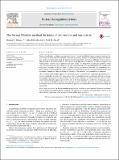Files in this item
The Parzen Window method : in terms of two vectors and one matrix
Item metadata
| dc.contributor.author | Mussa, Hamse Yussuf | |
| dc.contributor.author | Mitchell, John B. O. | |
| dc.contributor.author | Afzal, Avid | |
| dc.date.accessioned | 2015-07-06T10:10:01Z | |
| dc.date.available | 2015-07-06T10:10:01Z | |
| dc.date.issued | 2015-10-01 | |
| dc.identifier.citation | Mussa , H Y , Mitchell , J B O & Afzal , A 2015 , ' The Parzen Window method : in terms of two vectors and one matrix ' , Pattern Recognition Letters , vol. 63 , pp. 30-35 . https://doi.org/10.1016/j.patrec.2015.06.002 | en |
| dc.identifier.issn | 0167-8655 | |
| dc.identifier.other | PURE: 194595128 | |
| dc.identifier.other | PURE UUID: a6c2387e-84ee-4a9b-a820-d222b9b2c8e9 | |
| dc.identifier.other | Scopus: 84935457462 | |
| dc.identifier.other | ORCID: /0000-0002-0379-6097/work/34033384 | |
| dc.identifier.other | WOS: 000359888900005 | |
| dc.identifier.uri | https://hdl.handle.net/10023/6909 | |
| dc.description | We thank the BBSRC for funding this research through grant BB/I00596X/1. JBOM thanks the Scottish Universities Life Sciences Alliance (SULSA) for financial support. | en |
| dc.description.abstract | Pattern classification methods assign an object to one of several predefined classes/categories based on features extracted from observed attributes of the object (pattern). When L discriminatory features for the pattern can be accurately determined, the pattern classification problem presents no difficulty. However, precise identification of the relevant features for a classification algorithm (classifier) to able to categorize real world patterns without errors is generally infeasible. In this case, the pattern classification problem is often cast as devising a classifier that minimises the misclassification rate. One way of doing this is to consider both the pattern attributes and its class label as random variables, estimate the posterior class probabilities for a given pattern and then assign the pattern to class/category for which the posterior class probability value estimated is maximum. More often than not, the form of the posterior class probabilities is unknown. The so-called Parzen Window approach is widely employed to estimate class-conditional probability (class-specific probability) densities a given pattern. These probability densities can then be utilised to estimate the appropriate posterior class probabilities for that pattern. However, the Parzen Window scheme can become computationally impractical when the size of the training dataset is in the tens of thousands and L is also large few hundred or more). Over the years, various schemes have been suggested to ameliorate the computational drawback of the Parzen Window approach, but the problem still remains outstanding and unresolved. In this paper, we revisit the Parzen Window technique and introduce a novel approach that may circumvent the aforementioned computational bottleneck. The current paper presents the mathematical aspect of our idea. Practical realizations of the proposed scheme will be given elsewhere. | |
| dc.language.iso | eng | |
| dc.relation.ispartof | Pattern Recognition Letters | en |
| dc.rights | © 2015 The Authors. Published by Elsevier B.V. This is an open access article under the CC BY license (http://creativecommons.org/licenses/by/4.0/). | en |
| dc.subject | Probability density function | en |
| dc.subject | Kernel functions | en |
| dc.subject | Parzen Window | en |
| dc.subject | QD Chemistry | en |
| dc.subject | T-NDAS | en |
| dc.subject.lcc | QD | en |
| dc.title | The Parzen Window method : in terms of two vectors and one matrix | en |
| dc.type | Journal article | en |
| dc.contributor.sponsor | BBSRC | en |
| dc.description.version | Publisher PDF | en |
| dc.contributor.institution | University of St Andrews. School of Chemistry | en |
| dc.contributor.institution | University of St Andrews. Biomedical Sciences Research Complex | en |
| dc.contributor.institution | University of St Andrews. EaSTCHEM | en |
| dc.identifier.doi | https://doi.org/10.1016/j.patrec.2015.06.002 | |
| dc.description.status | Peer reviewed | en |
| dc.identifier.grantnumber | BB/I00596X/1 | en |
This item appears in the following Collection(s)
Items in the St Andrews Research Repository are protected by copyright, with all rights reserved, unless otherwise indicated.

